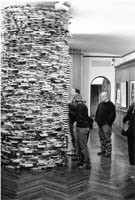
Was Oberlin more eager for the chance to see art from Eastern and Central Europe--an area long cut off from and mythologized by the West--or for the chance to hear Polish historian, journalist, and activist Adam Michnik speak?
Answering such questions is all but impossible. Just as it is equally difficult, as the Allen Memorial Art Museum's spring 1996 collaboration with the Department of Politics made clear, to draw static distinctions between artistic and political activity.
Beyond Belief: Contemporary Art from East Central Europe and Michnik's visit were part of the museum's ongoing effort, supported by a Mellon Foundation grant, to gear museum exhibitions "toward a broader segment of campus," says Amy Kurlander, curator of modern and contemporary art. By working together, museum staff and politics faculty designed a program that allowed the political and cultural environment of Eastern Europe to be explored through the work of the region's intellectuals and artists.
While the museum relies strongly on works from its permanent collection, traveling exhibits such as Beyond Belief, organized by Chicago's Museum of Contemporary Art, are occasionally utilized. A collection of works by artists from Bulgaria, the Czech Republic, Hungary, Poland, Romania, and Slovakia, Beyond Belief introduces the region's contemporary visual culture to America and explores art's function before and after the social and political transformations of 1989. Dealing artistically with the cultural legacies of Communism does not, as Western media often suggests, entail "substituting one belief system for another," wrote exhibit curator Laura Hoptman in the exhibition catalog. Rather, artists have responded by "attacking the very concept of ideological structures."

Matej Kren's Idiom challenged the notions of truth and conventional wisdom. Viewers who peered inside the hollow cylinder's tear drop shaped opening momentarily felt as if they were suspended inside an infinite tunnel of books, an illusion created by the mirrors placed inside.
Adam Michnik was similarly inspirational and unsettling. Currently editor-in-chief of Poland's largest daily, Gazeta Wyborcza, Michnik defies easy categorization. Prolific author, cofounder of KOR (Committee for the Defense of Workers), an activist at the forefront of the Solidarity movement, and a member of Poland's first noncommunist parliament, he spent six years in Polish prisons for opposing the Communist regime.
Introducing Michnik to his Finney Chapel audience, Visiting Professor of Politics Marjorie Castle quoted his description of the contemporary intellectual as "the nail in the shoe of normal society," suggesting that he had accurately characterized his own role with that statement. His subsequent remarks did much to prove her right.
Rather than speak directly of the exhibition, Michnik discussed the situation in Eastern Europe, specifically Poland, since 1989. Nonetheless, his remarks about the difficulty of "rebuilding collective responsibility and community," and his critique of contemporary culture's failure to find, as he put it, a new language with which to reply to Communism, were relevant to the issues raised by Beyond Belief.
Michnik condemned "chauvinism . . . articulated as faith in the ethnic state," as vociferously as what he described as "postmodern chaos and escape from values." Many of his comments elicited good-humored laughter from the audience and from Michnik himself, as did his wry closing question, "Is this a postcommunism of postmodernism or is it a postmodernism of postcommunism?"
--RACHEL COHEN was the Oberlin Alumni Magazine's editorial assistant during the 1995Ð96 academic year. An English and politics major, she will spend fall semester studying Czech and Eastern European politics, contemporary Czech literature and art, and the Czech language at Charles University in Prague.
The AMAM was one of only four U.S. museum's to host Beyond Belief, which will be exhibited at Philadelphia's Institute of Contemporary Art until November 2, 1996, and at the Joslyn Art Museum in Omaha from February 1 to April 6, 1997.